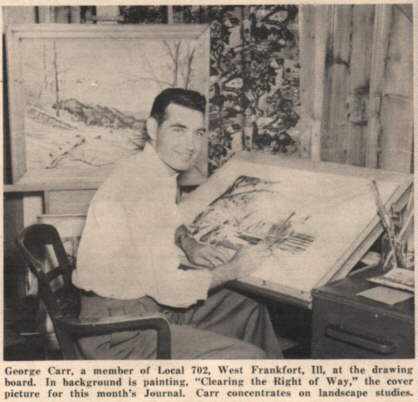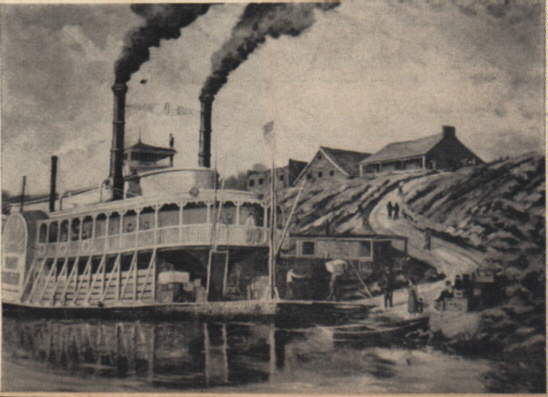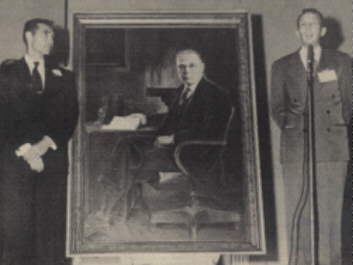
France -- WWII
IN MEMORY OF MY UNCLE
GEORGE WILLIAM CARR
SOUTHERN ILLINOIS ARTIST
(24 October 1909--21 June 1991)
by William R. Carr

France -- WWII
|
|
 |
Above (right): George in his home studio.
Below: Taken from The Electrical
Worker's Journal of February, 1953.

This oil painting entitled "Clearing the Right of Way,"
was featured on the cover of the February, 1953 issue
of The Electrical Worker's Journal. Uncle George was
working for the R.E.A. as a line-crew driver at the time on
William's Hill in November of 1951. An unexpected early
snowfall turned the fall landscape into a winter scene in a
matter of only a few hours as the men worked clearing the
right-of-way (as you can see - the hard way).

Also featured in the Journal was this painting of a Steamboat at the
Shawneetown Levee.
|
|

The cover of the December, 1952 issue of The Southeastern
Light, the Southeastern Illinois Electric Cooperative Magazine
-- forerunner of REN and later ILLINOIS Country Living magazines.
The watercolor is entitled "The Wire Stringers."
|
|
|
|

Watercolor of "The Old Gibbs Place"
This house was located on the east side of State Route 34 about a mile south of Rudement. George Carr's home was almost opposite the Gibbs' place, and just to the north. Andrew Duncan and his family lived there in the '50s. Later, Lawny Hayden lived there. All, including the house are all gone.

George Carr (left), presenting his life-sized oil painting
of Harry (Bull) Taylor to the Harrisburg Township High
School. Bull Taylor was the principle of the high school for
several decades. From the cover of the Oct. 1953 issue of
The Southeastern Light. The painting was later donated
to the Saline County Museum where it is now on display.
George Carr was a man of energy, ambition, and much talent. Though he painted throughout his life, he never made a living at it. He is best remembered by many in Harrisburg as being a rather strict, but highly respected, junior high industrial arts teacher. His wife, Gertrude, was also a teacher at the same school. George Carr left a legacy of watercolor and oil paintings of rural Southern Illinois, old homesteads, country bridges, and farm buildings, which will be enjoyed by many for generations to come.
While the family had hoped George would become a physician, George preferred to pursue an art career. He attended college at the Carbondale after high school and then attended an art school – and he studied for a while in Harrisburg under the enigmatic Penny Cent, a.k.a. Penrod Centurion. During the Depression he worked on the WPA Arts Project (as did Penny Cent).
Before World War Two George married Ruth Bartlett, and George built them a beautiful home on a parcel of land which was part of the family "homestead" a mile south of Rudement, Illinois. After the Attack on Pearl Harbor, George enlisted in the Army and was deployed to the European theater, and served primarily in France as a truck driver in a transportation division. Unfortunately, the separation due to George's foreign army deployment during the war apparently resulted in Ruth's infidelity and they divorced shortly after George's return home.
After returning home George was employed as a line crew truck driver by the Southeastern Illinois Electrical Coop, where he met his second wife Gertrude Fulkerson. His second marriage proved to be a marriage made in heaven, for they lived the balance of their lives together in what always seemed perfect happiness. It was a pity that George and Gertrude were unable to have any children. The only one they almost had was prematurely still-born.
All the while, George was continuing his painting and was gaining a solid reputation as an artist. Partly as a consequence of this, he was offered a teaching job at the Harrisburg Junior High School as a manual arts instructor. As part of the employment agreement, he would resume his university education on a part time basis and earn his teaching credentials. He remained at this job until he finally retired, but he never ceased producing his artwork. His specialty was watercolors, and his favorite subjects were local rural scenes, farmsteads, and barns. The measure of a true artist is that he produce art regardless of monetary rewards. And George certainly measured up. He did quite a bit of painting on a commission basis, but mainly he painted because he was driven by his inner artist to do it.
I'll never forget my first impression of my Uncle George. I was ten years old, meeting him for the first time since I was a baby too young to remember. I was impressed with his extraordinary good looks, ready laugh, big broad smile with perfect white teeth, and refined appearance. One could instinctively tell he was a perfectionist – in fact, he seemed "perfection personified." Not that he strove to have that appearance, or put on the dog in any way, but quality and class simply seemed to emanate from his person. Not only was that my first impression, but my opinion of him never changed thereafter.
In fact, as I got to know my Uncle George better, to my mind he was (and remained) a role model's model. He differed markedly from my dad, his brother – James Carr, who insistently avoided spit and polish and tended to be the outsiders' outsider. The contrast was striking in so many ways though they shared many physical similarities as well as many of the same native talents. Still, I admired just about everything about George, from his painting and model building, puppet making, to the wonderful home he had built, and his lovely wife, Gertrude.
George passed away in 1991 after a long and fruitful career. He shared his life with his wife, Gertrude, who passed away in August of 2003.
William R. Carr
Your are visitor number since 11 September, 2003. Thanks for visiting.